Author :
Abstract
Giyilebilir teknolojinin yaygınlaştığı çağdaş çağda, sensörlerin bu cihazlara entegrasyonu günlük hayata hızla nüfuz etti. İnsan Aktivitesi Tanıma (HAT) alanındaki gelişmeler özellikle dikkate değerdir; burada bir kişinin aktiviteleri, insan hareketlerine duyarlı sensörlerin kullanımıyla fark edilir. Akıllı telefonlarda İnsan Aktivitesi Tanıma özelliğinin yaygınlaşması, kullanıcı deneyimlerini önemli ölçüde artırdı ve bu cihazların teknolojik yeteneklerini genişletti, sonuç olarak bireylerin günlük rutinlerinde her yerde bulunmalarını güçlendirdi. İnsan Faaliyeti Tanıma'nın (HAT) önemi ve popülaritesi, akıllı telefonlar ve insan faaliyeti verilerini toplayabilen video kameralar gibi yakalama cihazlarının yaygın kullanımıyla kolaylaştırılan çeşitli uygulamalarla vurgulanmaktadır. Son yirmi yılda, İnsan Aktivitesi Tanıma (HAT), uzaktan sağlık izleme, güvenlik ve gözetim ve akıllı ortamların geliştirilmesi gibi çeşitli alanlarda uygulamalar bularak büyük ilgi gördü.
Bu bilimsel çaba, çeşitli makine öğrenimi sınıflandırma metodolojilerini kullanarak, akıllı telefon sensörlerini kullanan insan etkinliklerinin tanınmasına odaklanıyor. Özellikle akıllı telefonlara yerleştirilmiş ivmeölçer ve jiroskop sensörlerinden elde edilen veriler, insan faaliyetlerinin belirlenmesinde temel teşkil ediyor. Bu çalışmanın temel amacı, 18 farklı insan faaliyetini kapsayan akıllı telefon sensör verilerinin analizi yoluyla insan hareketlerinin tespit edilmesidir. Elde edilen veri kümesi, K-NN, Karar Ağacı, Rastgele Orman, SVM, LGBMClassifier, Bootstrap Aggregating Sınıflandırıcı, Evrişimsel Sinir Ağları (CNN), ve Tekrarlayan Sinir Ağları (RNN) gibi farklı makine öğrenimi algoritmaları kullanılarak bir veri seti üzerinde sınıflandırma analizi gerçekleştirilmiştir.
Keywords
Abstract
In the contemporary era, where wearable technology became widespread, the integration of sensors into these devices rapidly penetrated daily life. Developments in human activity recognition (line) field are particularly remarkable; Here, a person's activities are noticed by the use of sensors sensitive to human movements. The spread of human activity recognition on smartphones significantly increased user experiences and expanded the technological capabilities of these devices, as a result, strengthened individuals in their daily routines everywhere.
Human activity is emphasized by various applications that are facilitated by widespread use of capture devices such as the importance and popularity of recognition (line), smartphones and video cameras that can collect human activity data. The increasing number of electronic devices and their applications in artificial intelligence (AI) merged with the progresses recorded, and the release of confidential information for definitive recognition and interpretation. In the last twenty years, human activity recognition (line) has attracted great attention by finding applications in various fields such as remote health monitoring, safety and surveillance and development of smart environments.
This scientific effort focuses on the recognition of human activities using smartphone sensors using various machine learning methodologies. In particular, the data obtained from accelerator and gyroscope sensors placed on smartphones are the basis for determining human activities. The main purpose of this study is to detect human movements through the analysis of smartphone sensor data covering 18 different human activities. Classification analysis was performed on a data set using different machine learning algorithms such as data set, K-nn, decision tree, random forest, SVM, LGBMClassifier, Bootstrap Aggregating Classification, Evolutionary Neural Networks (CNN), and Recurrent Neural Networks (RNN).
Determined Results,
The number of neighbors for the K-NN technique is determined as 17. According to the results of the analysis, the highest success rate was obtained on the FIX_walking label with 97.76 %and the lowest success rate was obtained on the Sitting label with 76.42 %.
In the decision tree analysis, the random_state parameter was selected as 8 and the average success rate for all labels was determined as 92.55 %. According to random forest classification results, the Max_Depth parameter was determined as 2 and the highest success was obtained on the FIX_walking label with 98.38 %and the lowest success was obtained on the Sitting label with 78.28 %.
In SVM analysis, gamma and kernel parameters were determined and the average success rate for all labels was 87.55 %. The highest success with LGBMClassifier was obtained on the Sleeping label with 98.13 % and the lowest success with 90.32 %.
The best achievement in Bootstrap Aggregating Classification Analysis Sleeping was obtained in the lowest success Sitting label and the average success rate was 94.22 %.
The highest success compared to evolutionic neural networks (CNN) analysis was achieved on the SLEEPING label with 97.07 % and the lowest success was obtained on the Sitting label with 89.89 %.
The highest success in recurrent neural networks (RNN) analysis was obtained on the FIX_WALING label with 96.27 %and the lowest success was achieved on the Sitting label with 58.51 %. The average success rate of all labels was 93.84 %.
This data set, which is created in this way, not only gives smart phones and other smart devices to detect new events, but also provides valuable empirical foundations for researchers to develop models based on practical human activity recognition (HAR) data.





